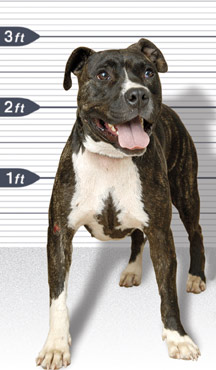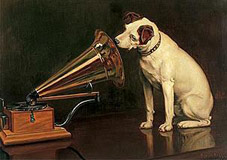 |
||
 |
||
|
|
||
July 2005: Monster hunt, extreme bird watchers, the L.A. Lint Roller Party, and more |
||
|
|
|

Part One: Dangerous Breeds?
Is it right to breed dogs whose primary purpose in life is to fight? From the September/October Best Friends magazine. Bad Dogs...or Bad Rap?What's to be done about the pit bull problem?By Julie RichardFrom Best Friends magazineThis is the second of two articles looking at the laws, the debate, and the underlying problems faced by potentially dangerous dogs and the people who love them.Dangerous Breeds: Part One Jason loved his dogs more than he loved anything else in his life. At age 18, he hadn't walked the smoothest of roads. An inner-city kid on the lower end of the economic scale, he suffered from severe learning disabilities and wasn't yet able to strike out on his own. He lived in a small apartment with six other siblings and his mother. They didn't have the things that middle-class kids his age collect easily - no cars or motorcycles, computers or I-Pods, DVD players or mobile phones. What he did have was two pit bulls. They were his constant companions, accompanying him everywhere. He cared for them himself, feeding and walking them, and the trio all slept in the same bed. Unlike many youths in his neighborhood who also had dogs, Jason never taught his to fight. They were simply the cuddly variety - two big pussycats in pit bull attire. Then Jason's mother remarried, and his new stepfather was abusive. He hated dogs, and he hated the affection Jason lavished on his pups. As the new head of the household, he now made the rules, and Jason's life changed along with his animals. The stepfather decided the house was off-limits to the dogs, and they were promptly shut outside in a contained yard behind the building - without food, water, or any means of escape. And he made sure they were locked in tight. Nobody could get to those dogs. Jason was ordered to have no contact with them. He couldn't pet them. He couldn't take them on walks. And he couldn't feed them. His stepfather was intent on simply starving the animals to death before Jason's eyes. But Jason loved those dogs. And he wasn't going to let them die. Not knowing what to do, not having the mental capacity to find another way out, he resorted to quietly defying his stepfather by sneaking up to the roof of his building and throwing food down to the animals. He tried to take care of them the best he could, but clearly it wasn't enough. The neighbors, hearing the dogs' plaintive howls, knew they had to intervene. They called animal control. The animals were carted away, and cruelty and neglect charges were slapped on their owner - Jason. Being 18 made him an adult in the eyes of the law, and despite the circumstances, he was convicted. The dogs, being pit bulls, were labeled "unadoptable" and destroyed. In Jason's case, the system failed the kid, and it failed the dogs. But if it seems like a freak occurrence, unfortunately it's not. Just as Jason was labeled an animal abuser without any deeper consideration of his circumstances, so too are dogs all across the country being targeted simply because they have rather square heads and powerful jaws, because their bodies are a bit stout and muscular. In short, because they're pit bulls. So what is a pit bull?There are wars all around us these days - in the news, on the streets and, for pit bulls, in a list of cities and towns across the country that seems to expand daily. Unquestionably, there are more pit bulls around than ever before. And many of them are aggressive, even dangerous, because that is what the humans who have them in their charge want from their dogs. But pit bulls, despite their press, are not naturally aggressive toward humans. What we call a pit bull today originally descended from the Molossus, a large, mastiff-like dog originating in ancient Greece before making its way to Britain on trading ships. A number of dogs emerged from that one breed, including mastiffs, alaunts, and bulldogs. The latter became the dog of choice for Tudor England's thirst for blood sports such as bull and bear baiting. When the Victorians put a stop to that, dog fighting became the trendy new sport, and somewhere along the way, the old bull-baiting dog was crossbred with a terrier, giving it both strength and speed. It's believed this breeding practice began in Staffordshire, England. Hence the name Staffordshire bull terrier. When America was colonized, people brought their dogs. In 1898, the American pit bull terrier became the foundation breed of the UKC, a new canine registry. Because it didn't have pure bloodlines, the AKC wouldn't even recognize the dog for years.  By World War I, pit bull terriers had become America's dog. Their strong bodies, sweet temperaments, dependability and loyalty made them the nation's canine mascot on war posters. They were used in countless advertising campaigns in the following decades. Victor, RCA's famous canine riveted by his master's recorded voice, was a pit bull. And a pit bull "sold" shoes for Buster Brown. They were the dog of choice for legions of celebrities, from Thomas Edison to Fred Astaire to Woodrow Wilson. And they became celebrities themselves. Petey, the Little Rascals mascot, romped alongside his grade-school pals with their parents' blessing. They knew the dog was their friend. He would never do them harm. By World War I, pit bull terriers had become America's dog. Their strong bodies, sweet temperaments, dependability and loyalty made them the nation's canine mascot on war posters. They were used in countless advertising campaigns in the following decades. Victor, RCA's famous canine riveted by his master's recorded voice, was a pit bull. And a pit bull "sold" shoes for Buster Brown. They were the dog of choice for legions of celebrities, from Thomas Edison to Fred Astaire to Woodrow Wilson. And they became celebrities themselves. Petey, the Little Rascals mascot, romped alongside his grade-school pals with their parents' blessing. They knew the dog was their friend. He would never do them harm. How times have changed. Fighting the witch huntToday, pit bulls are being increasingly vilified. As communities respond to both dog attacks and the media's hyping of any incident involving the breed, laws are being enacted that place pit bulls in the cross-fire. It's a trend that's disturbing to those in the humane community, many of whom view it as a knee-jerk reaction designed to assuage public perception without actually addressing the underlying problems. Jill Buckley is the ASPCA's legislative liaison. She spends endless hours working on the issue of breed-specific legislation. Whenever a new county or town starts considering a pit bull ban, she offers alternative and better solutions - ones that will address the problem rather than the breed. And the problem is people.  "Any dog can bite," she says. "It doesn't make sense to legislate against a particular breed when it's the training of the dog, the responsibility of the owner to keep control and take care of it in a humane way. That is the issue. It means getting the dog fixed, not training it to fight, not tying it up outside. It means making it a member of the household. All those factors will determine whether a dog will be a biter or not, not specifically the breed." "Any dog can bite," she says. "It doesn't make sense to legislate against a particular breed when it's the training of the dog, the responsibility of the owner to keep control and take care of it in a humane way. That is the issue. It means getting the dog fixed, not training it to fight, not tying it up outside. It means making it a member of the household. All those factors will determine whether a dog will be a biter or not, not specifically the breed."Regardless of whether one is for or against breed legislation, there is one invariable factor affecting these dogs: people. It's people who breed them, people who train them to fight or be fiercely protective, which leads to attacks. It's people who neglect or abuse them. And it's people who love them and can't understand why their dogs are being picked on. Like most things involving people, solving the myriad problems that have emerged with the animals is complex. Council Bluffs, Iowa, sits nestled in America's heartland. Perhaps it's not the first city that comes to mind when one thinks "trend-setting," but with larger metropolises such as Boston and Denver rushing to slap breed-specific legislation on the books, the city that's known as the "gateway to the American West" took a different approach. Instead of focusing on the dogs, they're turning the spotlight on humans. After a dozen pit bull attacks, the city council discussed passing a breed ban. But at public hearings, legislators listened while pit bull owners took the floor and pled their dogs' case. They all had the same basic message: "It's not the dogs; it's the people." The councilors took note. Instead of a ban, they instituted a three-strikes law for owner/guardians. The new ordinance lists a host of offenses for animal abuse and care, including leash laws and licensing. Anyone violating the ordinance twice in a year is deemed an "irresponsible pet owner." A third violation means their animal will be taken away, and they will be barred from having pets for 36 months. And the councilors, along with the local police, intend to enforce the ordinance rigorously. Dogs, drugs, fights, and moneyIt's that kind of focus that those opposing breed legislation applaud. But others believe that the problem is so profound, and owner/guardian responsibility so impossible to legislate, that the only way to conquer the situation is to focus on the breed. Lucas County, Ohio, has had pit bull restrictions in place since 1987. The law was passed after a few incidents of dog bites made the headlines. Their law doesn't ban pit bulls outright, but it does automatically label them "vicious dogs." As such, they're required to be confined in a kennel with a top on it. When walked in public, they have to remain on no more than a six-foot lead. And their guardians must carry a $100,000 home insurance policy that covers dog bites. Dogs other than pit bulls can be labeled vicious if they've bitten a person or attacked another animal. But for pits, the assessment is routine. Tom Skeldon, the head of animal control, insists that the regulations have made the community safer - that while the number of dogs coming through his shelters has sharply declined since the 80s, the number of vicious dogs has skyrocketed. And most of those dogs are pit bulls. For Skeldon, it's the humane community that's gotten caught up in hype rather than the localities. "I think a lot of humane organizations are being used unwittingly by people who are making money off of pit bulls and these types of dogs," he says. "There is an economy that has sprung up in every major city in the U.S. and most of Europe that has an unholy alliance between pit bulls and dog fighting and drug dealing, and you don't have to be directly involved in dog fighting or in drug dealing to profit from that economy. You can be veterinarians that treat these dogs; you can be people that never participate in dog fighting and never do drugs but your father or grandfather left you a line of fighting pit bulls, and you just sit back and breed these dogs and you sell them. I don't care what their pedigree is, they are all salable in big cities in this country. So if a dog has a temperament problem or genetic problem, it doesn't matter. They're good fighting dogs. There's a benchmark price that's increased since dog fighting has increased." But what is also increasing is the number of much-loved pit bulls who are abandoned because such restrictions can become cost-prohibitive. The insurance biteThe dog was rescued off the street. Tired, sad, and hungry, he'd been abandoned for being a lover not a fighter and therefore, no good to whoever was responsible for his scars. A young couple found him and scooped him up. At first, they didn't intend to keep him, but his warm demeanor and clear gratitude quickly won their hearts. But his new people wanted to ensure that no emotional damage from his early ordeal might one day lead to an unexpected outburst of aggression. So they took him to the finest behaviorists for assessment and training, and they followed all the expert advice to the letter. And it worked. There were no behavioral problems. They were just one big, happy family. Until the town they lived in passed an ordinance declaring that all pit bulls must be in high fenced yards and their families must carry a hefty insurance policy. The fence was no problem. They built one, and it was extra high. The insurance policy was another matter. They couldn't get one that would cover the dog. They tried several companies, but the premiums were either far out of their reach, or they were simply denied. Not knowing what to do, where to place him, or how to get by without insurance, they made the decision to have their dog euthanized. When breed legislation is passed, if it doesn't call for an absolute ban, it almost always requires large insurance polices. And the insurance industry is responding by placing their own prohibitions on what dogs they're willing to insure. Several companies won't take on pit bulls at all. Others say they don't discriminate, but the moment insurers discover the family dog is a pit bull, they're not interested in writing a policy. A few others have softened their stance a bit by accepting breeds previously "ineligible" to them if they complete a Canine Good Citizen program and receive AKC certification. Overall, the number of companies that still offer insurance is shrinking and premiums are growing. Ironically, it's careful, law-abiding people who are suffering the most. They're the ones who take out insurance, who build higher and better fences, who watch their dogs carefully, and who are more likely to spend money on behavioral assessment and training. Drug dealers and dog fighters are hardly the first in line to sign up for a steep homeowner's policy. What does a pit bull represent? Responsible owners have yet another cross to bear: how society perceives them. They're often viewed with disdain by other people - the prevailing attitude is that if they have a "vicious" breed of dog, there must be something wrong with them emotionally. Responsible owners have yet another cross to bear: how society perceives them. They're often viewed with disdain by other people - the prevailing attitude is that if they have a "vicious" breed of dog, there must be something wrong with them emotionally. But perhaps that mindset is expressing something else. Stephanie LaFarge thinks so. A psychologist based at New York's ASPCA, LaFarge has both provided counseling and consulted on cases of animal abuse that most of us couldn't possibly bear to even hear about. Many are the worst of the worst. She's watched the epidemic of pit bull aggression and the legal response to it. And she has a different take. "A lot of the anger that we have toward pit bulls is a disguised displacement that we have toward inner-city populations," she says. "Legislation against dangerous dogs is primarily enacted by the majority middle class, but the fact is that these dogs are intrinsically identified with the inner cities - with people who are frightening to us. It's politically incorrect to say 'I'm scared of X group,' so often people will say, 'I'm scared of the dogs.' But what they really mean is 'I'm scared of the people that are associated with that dog.' The connection is very intimate." And aggression is intimate, too - even in the most well-meaning of dog owners. Studies have examined ties between aggressive dogs and their owners' personality traits, and there is evidence that owner personality and the expression of canine behavior may be linked. People who are less self-confident are more likely to have aggressive animals. People who are more aggressive themselves often have aggressive pets - just as very nervous people can often spawn very nervous dogs. LaFarge believes that the owner unconsciously does control canine behavior, even if they're responsible people who would never intend to harm anyone. "Body language is a very subtle thing," she says. "There is a message that goes down the leash. A fearful person doesn't have to make much of an adjustment to communicate their fear to the dog. And the dog feels that their person is uptight and thinks, 'I need to be afraid of this person coming toward me.' That message happens in seconds, completely out of the person's awareness. It takes only the tiniest response in the human hand to send a message to the dog saying, 'This is dangerous.' That's why people need to understand themselves, what their connection to their dog is, and what's going down the leash." Fear and hostility work both ways. So while middle-class America might feel threatened by inner-city populations, LaFarge knows well that those who live in the inner cities, the people who have pit bulls for both their own protection on the mean streets and as an economic source, also have negative feelings that can be unintentionally communicated to the dog. Not too long ago, there was a rash of pit bull attacks on small Yorkies in New York City. LaFarge counseled a number of women, all white and either wealthy or middle class, whose dogs had been viciously attacked on the street. The pattern was uncannily alike. "All the cases were cross-race," says LaFarge. "It was clear to me that the sight of a white lady with this small little Yorkie was unconsciously - or consciously - inflammatory to these young men, and permission to go after the little dog was given by the owner. The little dogs were dead in seconds. Some people said that the owner gave implicit instructions. But I think body language played more of a part. It's commonsensical that for a person who is poor, encountering a person of some wealth with a small vulnerable dog is an enraging thing. It's a little like road rage - just the existence of this woman and her dog was enough of a provocation for them." The prosecutorIt's 2:10 p.m., Pacific Standard Time, and Robert Ferber is officially against breed legislation. Ten minutes earlier he was for it, and he admits that he may be again 20 minutes from now. It's not that Ferber is vacillating; it simply speaks to the complexity of the issue for him. Ferber has a unique position in the country when it comes to animals and the law. He's the only city attorney in the nation whose exclusive domain is animal abuse. He also has a pit bull. And it's his own dog who gives him pause. He's had many animals in his life, but he recognizes something unique about Miss Amy. She was an abandoned fighting dog who is missing one eye and most of her teeth as a result. He loves her madly but says that he can feel her predatory instinct. She's been aggressive toward other dogs and has required extensive training to fit comfortably into a family that includes a Rottweiler and cats. "Everyone who expresses an opinion, either for or against, all make sense," he says. "That's part of why I go back and forth. I think in some ways we're guessing, based on anecdotal evidence and our own logic and experience across the board. I don't know if any of us is an expert on this question." But Ferber is an expert on the law, and he sees a vicious circle at the heart of the dangerous dog crisis. He prosecutes case after case of severe neglect and abuse. And most of the dogs involved are pit bulls. But he also notes that part of the problem is that Los Angeles's municipal shelters have no adoption screening process. Fear of discrimination lawsuits if adoptions are denied has led to an open-door policy. That's bad news for the dogs. It means that anyone who abuses an animal, who wants a pit bull for purposes of fighting or aggressive protection, can walk into a shelter and walk out with a dog, no questions asked. Many of these people end up in front of Ferber on the other side of a courtroom. Ferber is sickened by that situation. Along with the temperament testing of dogs that seems to be so popular at the moment, he believes "there should be temperament testing of people. We'd have a lot fewer dogs ending up where they do." One thing is certain: Right now, like so many things in our country, political correctness is winning the day. Legislators pass laws that don't work effectively so it appears that they are protecting the public. Shelters form policies based on potential public reaction. The humane community focuses on "owner responsibility" in a society where personal responsibility has become so virtually non-existent that any suggestion that it should be assumed is likely to evoke accusations that constitutional rights are being trammeled. And the public just wants the dogs and their people out of the neighborhood. Meanwhile, tomorrow or the next day will bring another story of a pit bull attack. Elsewhere, someone interested in making a quick $500 will be watching their own pit bull deliver pups that they will then raise to be aggressive to appeal to the buyers who want them. A new city will announce that they're enacting breed legislation. Another insurance company will refuse coverage to a family with a pit bull. A public prosecutor won't bring an animal abuser to trial because there's just not enough time to deal with his caseload. A shelter will kill a pit bull because the breed is "unadoptable." Round and round the circle goes, and where it stops, nobody knows. |
|



